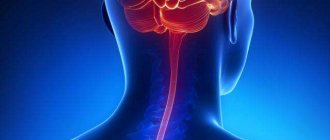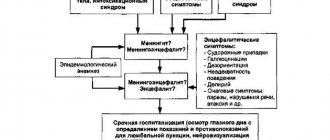Causes of purulent meningitis
The main pathogen leading to infection with purulent meningitis is meningococcal infection. However, in recent years, scientists have proven that not only it leads to the disease, but also Haemophilus influenzae and pneumococci. In half of all cases, the causative agent of purulent meningitis will be Haemophilus influenzae, while meningococcus accounts for no more than 20%, and pneumococci - only 12-13%.
Purulent meningitis also occurs in newborns. The reason for this will be streptococcal infection or salmonellosis. Additionally, infected E. coli may also be a major pathogen.
Regarding the routes of penetration of the pathogen into the human body, purulent meningitis is classified into:
- primary: development is facilitated by the hematogenous spread of the pathogenic rod from the nasal cavity, where it enters when a person breathes; it is easy to become infected through contact with sick people (airborne or contact); direct infection of the meninges occurs in the case of an open type of traumatic brain injury, skull fracture or any other open injury to the paranasal sinuses (or mastoid process); failure to comply with hygiene rules during neurosurgical operations is another possible cause of infection;
- secondary: occurs on the basis of an already existing primary focus, from which the infection spreads to the brain area; The nature of the spread of infection can be either contact (with a brain abscess or osteomyelitis of the cranial bones) or hematogenous, spread from any source of infection is typical, but most often with sinusitis or otitis media.
If the causative agent of purulent meningitis enters the body through the blood-brain barrier, then the immune system is weakened. The latter can also be caused by acute respiratory viral infections or frequent stressful situations, as well as physical fatigue and changes in climatic zones.
Classification of purulent meningitis
Regarding the severity of symptomatic manifestations, the following forms of purulent meningitis are distinguished:
- light;
- medium-heavy;
- severe (typical for people with severely reduced immunity or those who have previously had their spleen removed).
Regarding the characteristics of the course of the disease, they speak of purulent meningitis:
- fulminant (characterized by a very rapid development of symptoms in the form of increased cerebral edema, which contributes to confusion and the onset of vital functions);
- abortive (has erased symptoms, where the first place is given to intoxication);
- acute (occurs more often than others; it is characterized by traditional cerebral and meningeal symptoms);
- recurrent (typical in the case of an advanced form, with untimely treatment or in the case when a chronic type of purulent infection is observed in the body).
Diagnostics
Taking into account the patient's complaints, the current clinical picture, typical symptoms of meningitis and the results of cerebrospinal fluid examination, in general, the diagnosis is not difficult to make. Otogenic meningitis must be distinguished from tuberculous, serous and cerebrospinal meningitis. Tuberculous meningitis most often occurs in children. Its course is slow and sluggish, the cerebrospinal fluid is serous, the number of cells is small - does not exceed 2000. Cerebrospinal meningitis is usually preceded by ARVI. It begins very violently, and when examining the cerebrospinal fluid, meningococcus is detected. With serous meningitis, lymphocytic pleocytosis is observed in the cerebrospinal fluid, sugar is within normal limits. With this disease, clinical manifestations of acute respiratory disease most often predominate, and neurological symptoms quickly disappear.
Friends! Timely and correct treatment will ensure you a speedy recovery!
Make an appointment right now!
Call us by phone or use the feedback form
Sign up
Symptoms of purulent meningitis
- The onset of purulent meningitis is usually acute and is characterized by a sharp increase in body temperature to 39-40°C. Along with the temperature, characteristic chills, severe headache of increasing character, nausea and vomiting appear. The patient's condition may be characterized by psychomotor agitation, confusion, and manifestations of delirium.
- About 40-45% of patients have a convulsive syndrome. The so-called shell symptoms: stiff neck, Kernig's sign, Guillain's sign, usually appear in the first hours of the disease, becoming more and more intense on the 3-4th day.
- Additional symptoms of purulent meningitis will be hyperesthesia, decreased abdominal reflexes, which is observed against the background of already increased activity of deep reflexes. It is possible that a diffuse rash of a hemorrhagic nature may occur.
- The focal symptoms that accompany purulent meningitis are understood, first of all, as a dysfunction of the cranial nerves. Most often, the oculomotor nerves are affected, which leads to double vision, further development of strabismus, the upper eyelid may droop or anisocoria (a noticeable difference in the size of the pupils) may appear. Neuritis of the facial nerve is much less common; damage to the trigeminal nerve or dysfunction of the optic nerves may occur, which is expressed in partial loss of the visual field and a decrease in its acuity. There is also a disruption in the functioning of the vestibulocochlear nerve, which in medicine is called progressive hearing loss.
- Severe focal symptoms indicate the continued spread of inflammatory processes occurring in the brain, as well as the development of vascular abnormalities similar to manifestations of ischemic stroke, which is explained by the presence of vasculitis, thrombosis of cerebral vessels or reflex spasm.
- If the inflammatory process completely extends to the substance of the brain, then we are talking about meningoencephalitis. In this case, purulent meningitis develops with the addition of special focal symptoms inherent in encephalitis (paresis or paralysis, impaired sensitivity, slurred speech, the occurrence of pathological reflexes, muscle irritability).
- Symptoms such as hallucinations, vestibular ataxia, hyperkinesis, sleep disturbance, memory and behavior disorders cannot be excluded.
- If the purulent process further spreads to the ventricles of the brain, a spastic attack may occur, unfolding like hormetonia with flexion contractures of the arms or extension of the legs.
Additional diagnostic measures
During the diagnosis, a blood test and analysis of the separated elements of the skin rash are also carried out. If a specialist suspects the presence of secondary purulent meningitis, then an additional examination is prescribed, the purpose of which is to identify the primary infectious focus. For this, the patient is sent for consultation to a pulmonologist, otolaryngologist or therapist. Effective diagnostic measures here would be otoscopy, x-ray of the paranasal sinuses, and x-ray of the lungs.
Differential diagnosis is carried out with viral meningitis, subarachnoid hemorrhage, meningism, which is also observed in typhus, leptospirosis and severe cases of influenza.
Complications of purulent meningitis
The most serious complication of purulent meningitis is cerebral edema, which compresses the brain stem, disrupting the functioning of vital centers located in it. Acute swelling occurs on the 3rd day from the onset of the disease. In the case of a lightning-fast course, the acute form appears already in the first hours.
According to the clinic, complications of purulent meningitis are most often expressed in motor restlessness, confusion, disruption of normal breathing and functioning of the cardiovascular system (in the form of tachycardia, bradycardia, arterial hypotension or arterial hypertension).
Other complications of purulent meningitis may include:
- septic shock;
- subdural empyema;
- adrenal insufficiency;
- purulent arthritis;
- pneumonia;
- pyelonephritis;
- infective endocarditis;
- cystitis;
- septic panophthalmitis.
Material and methods
We examined a complete sample of 281 patients who were hospitalized at Infectious Clinical Hospital No. 1 of Moscow in 2005-2007. for bacterial infections with purulent meningitis syndrome. 223 patients were admitted to the department of acute neuroinfections, 194 of whom were treated in the department and 29 patients, as their condition worsened, were transferred to the intensive care unit (11 of them died); 58 patients were initially admitted to the intensive care unit, 29 of them, upon improvement of their condition, were then transferred to a specialized department (29 died).
In addition to general somatic and neurological examination of patients, CSF was studied and bacteriological examination was carried out.
CSF was examined in 275 patients. For analysis, we mainly took data obtained during emergency admission of patients. Cytosis was expressed as the number of cells in 3 mm3 (3 μl) or the number of cells in 1 μl (more typical notation focused on 3 μl; for example, “cytosis 960/3”) [17, 30]. The leukocyte formula was determined by the traditional method using blood smears stained according to Romanovsky (azur-2-eosin) [21]. Leukocytosis was expressed in thousand per mm3.
The bacteriological study included: 1) microscopy of CSF smears stained by Gram, 2) the latex agglutination reaction (as an express method) to detect specific antigens of the main pathogens of bacterial infections in the cerebrospinal fluid [16], 3) the classical bacteriological method of CSF culture and blood on nutrient media [23].
In the differential diagnosis of bacterial and viral infections occurring with damage to the meninges, a statistical assessment (correlation coefficients, Student's test) of the significance of a number of symptoms, signs and laboratory parameters was carried out.
Treatment of purulent meningitis
For purulent meningitis, patients are treated only in a hospital. Patients should immediately undergo a lumbar puncture with further bacterioscopic examination of the cerebrospinal fluid. After the etiology of meningitis has been established, the patient is prescribed a course of antibiotics. The latter often involves the use of ampicillin with drugs from a number of cephalosporins, including cefotaxime, ceftriaxone and ceftazidime. If the causative agent of purulent meningitis is not identified, initial therapy consists of intramuscular administration of aminoglycosides or their combination with ampicillin. In severe forms of purulent meningitis, intravenous antibiotics may be prescribed.
To reduce brain swelling, dehydration therapy with mannitol and furosemide can be prescribed. If we talk about the pathogenetic type of treatment, it involves the use of dexamethasone or prednisolone, in a word, glucocorticosteroids. The prescribed doses will depend on the severity of the disease. In addition, doctors prescribe symptomatic therapy. If the patient also has a sleep disorder, then tranquilizers are prescribed. In order to relieve psychomotor agitation and eliminate seizures, lytic mixtures, as well as valproic acid or diazepam, are prescribed. Infusion therapy will be prescribed in the presence of infectious-toxic shock.
Prognosis of purulent meningitis
According to statistics, about 15% of all cases of purulent meningitis are fatal. If the diagnosis was made in a timely manner and treatment was started urgently, then the prognosis of the disease will be favorable.
It should be said that after a person has had purulent meningitis, he may develop asthenia with characteristic liquor-dynamic disturbances and inherent hearing loss of a sensorineural nature. Also, in some cases, subtle focal symptoms may be observed.
Such severe complications after suffering purulent meningitis, such as complete deafness, hydrocephalus, amaurosis, dementia or epilepsy, are very rare today.
Treatment of children
Treatment of purulent meningitis in children must be carried out in an infectious diseases hospital and begin as early as possible.
- Immediately after the child is hospitalized, therapy with broad-spectrum antibiotics (penicillin, ceftriaxone, cefotaxime) begins.
- As symptoms progress, antibiotics are administered endolumbarally, directly into the cerebrospinal fluid.
- The duration of the course of antimicrobial drugs should be at least 10 days.
- To prevent dehydration, intravenous infusions of saline and glucose are given.
- To prevent or reduce cerebral edema, diuretics (mannitol, furosemide) are prescribed.
- For severe convulsions, phenobarbital and sodium thiopental are used.
- In severe cases of the disease, additional oxygen support is provided through masks and nasal catheters.
The average length of hospitalization for childhood purulent meningitis is from twenty to thirty days. With self-medication and the absence of pathogenetic therapy for the disease, cerebral edema and displacement of its structures develop, which can lead to death two to three days after the onset of the disease.
Prevention of purulent meningitis
A proven surefire way to prevent purulent meningitis is vaccination. Typically, the goal will be to combat infection by major pathogens such as Haemophilus influenzae, pneumococci, or meningococci. Such vaccination is not mandatory, but highly recommended.
Vaccination is usually carried out among young children (usually under 5 years of age), as well as among people who have an immunodeficiency state due to the development of HIV infection in the body.
Interestingly, vaccination is also prescribed to people after removal of the spleen, thymus, or after immunosuppressive therapy for cancer patients. If we talk about vaccination against meningococcal infection, it is indicated for children older than 18-20 months, and is mandatory if the disease has been diagnosed in at least one family member. In those regions that are considered most susceptible to the spread of meningococcal purulent meningitis, vaccination should be carried out regularly, especially for people with immunodeficiency, as well as those who have traumatic brain injuries. Vaccinations should be carried out among children who often suffer from otitis media, pneumonia, or simply have low immunity.
Bacterial meningitis
Purulent bacterial meningitis (GBM)
is a group of infectious diseases whose pathogenesis is based on purulent inflammation of the membranes of the brain and spinal cord.
About 90% of all cases of purulent bacterial meningitis are caused by meningococci (Neisseria meningitidis types A, B, C, X, Y, Z, W-135, 29E, K, H, L, I), pneumococcus (Str. pneumoniae), Haemophilus influenzae type b (Haemophilus influenzae b, HIb). The next most common causative agent of HDM is staphylococcus, the main example being St. aureus, rare pathogens - streptococci, listeria, gram-negative rod-shaped flora. All pathogens of bacterial meningitis initiate purulent inflammation, accompanied by sharply increased vascular permeability. There are primary and secondary GBMs. Primary purulent bacterial meningitis is considered to be meningitis that develops in the absence of any purulent-inflammatory foci. Secondary GBM develops in the presence of a primary purulent focus (otitis media, sinusitis, pneumonia, endocarditis, osteomyelitis and others) or sepsis.
Purulent bacterial meningitis of meningococcal etiology is characterized by periodicity. The last epidemic rise of meningococcal infection in the Russian Federation was registered in the 80s of the twentieth century and was caused by meningococcus serogroup A subgroup III. Meningococcal infection is characterized by winter-spring seasonality, however, some increase in incidence is noted when teams of children's educational institutions, schoolchildren, and students are formed after the summer holidays. For purulent bacterial meningitis of non-meningococcal etiology, seasonality is not typical.
The source of pathogens of purulent bacterial meningitis is a person who is sick or a carrier of the pathogen. The route of transmission could not be simpler - airborne, that is, infection occurs when coughing, sneezing, or talking.
The disease develops acutely, the temperature rises with chills to 38-40°C, headache appears early and quickly intensifies, becoming unbearable, and repeated vomiting occurs. On days 1-2 of the illness, meningeal symptoms appear and rapidly increase; the characteristic meningeal posture (thrown head back and legs tucked to the stomach) appears no earlier than 3-5 days of illness. In most cases, already in the first days of the disease there is a change in consciousness. Psychomotor agitation, insomnia or drowsiness, delirium, and less commonly hallucinations are often observed. Children often experience convulsions and tremors of the limbs.
Currently, due to the widespread outpatient use of antibacterial drugs, the number of atypical forms has increased. In these cases, a subacute course with subfebrile or even normal temperature and minor intoxication is possible. Meningeal symptoms appear late, headache is mild, and vomiting is rare. In children, the course of the disease is undulating; in some cases, meningoencephalitis and ventriculitis develop, which are difficult to respond to antibacterial therapy.
For effective treatment, early hospitalization of the patient is necessary.
How to protect yourself from purulent bacterial meningitis? Vaccination is an affordable, safe and reliable protection against most pathogens of bacterial meningitis. There is no single vaccination against this serious and dangerous disease, since meningitis is caused by different pathogens. The most common causes of purulent meningitis are three types of bacteria - Haemophilus influenzae type B, meningococci and pneumococci.
Vaccinations against Haemophilus influenzae (HIB): According to epidemiological studies, Haemophilus influenzae type b (HIB) is the cause of up to half of cases of purulent bacterial meningitis in children under 5 years of age. Vaccination against Hib infection is recommended for all children without exception in the first year of life, starting from 3 months of age. In the Russian Federation, vaccinations against Hib infection are included in the National Preventive Vaccination Calendar and are given to children at risk:
- with immunodeficiency states or anatomical defects leading to a sharply increased risk of hemophilus influenzae infection;
— with oncohematological diseases and/or receiving immunosuppressive therapy for a long time;
- children born to mothers with HIV infection;
- children with HIV infection;
- children in orphanages.
The practical meaning of vaccination against Haemophilus influenzae for children under 1 year of age is to protect against the most dangerous forms of Haemophilus influenzae infection - meningitis and pneumonia, since the peak incidence of these forms of infection occurs at the age of 6-12 months. The relevance of vaccination increases significantly if the child attends a nursery or kindergarten; in children's groups, the proportion of CWD carriers reaches 40%. This is confirmed both by the frequent colds that are typical when starting to attend kindergarten, and by the effectiveness of vaccination against Hib infection, which can sharply reduce the level of carriage and the number of cases of acute respiratory infections. The classic immunization regimen includes 4 vaccinations against Haemophilus influenzae infection: vaccination at 3 months, 4.5 and 6 months, revaccination at 18 months. The main advantage of this scheme is the formation of immunity in the child to the most dangerous morbidity of CHIB meningitis and pneumonia at the age of 6–12 months.
Vaccinations against meningococcal infection are included in the preventive vaccination calendar for epidemic indications. Preventive vaccination for epidemic indications is carried out when there is a threat of an epidemic rise, namely when the incidence of the prevailing serogroup of meningococcus increases two or more times compared to the previous year, according to the decision of the chief state sanitary doctor of the Russian Federation, the chief state sanitary doctors of the constituent entities of the Russian Federation. The following are subject to vaccination with polysaccharide vaccine:
- children from 1 year to 8 years inclusive;
— first-year students of secondary and higher educational institutions, primarily in teams staffed by students from different regions of the country and foreign countries.
With the continuing increase in the incidence of meningococcal infection, the number of vaccinated persons for epidemic indications should be expanded due to:
— students from grades 3 to 11;
- the adult population when contacting medical and preventive organizations for immunization against meningococcal infection.
Vaccinations against meningococcal infection are also indicated for persons traveling for a long period of time to countries with a high risk of infection (the Sahara region, the United Arab Emirates, Saudi Arabia). When entering England, it is advisable, but if you are planning to study in the UK, you will have to do it. The vaccination is given once 10-14 days before departure; it protects the body from meningococcal meningitis for 3-5 years.
Vaccinations against pneumococcal infection: Purulent bacterial meningitis of pneumococcal etiology accounts for up to 15% of all bacterial meningitis. In Russia, vaccinations against pneumococcal infection are included in the National Calendar of Preventive Vaccinations, are given to children from 2 months of age and include vaccination at 2 and 4.5 months, revaccination at 15 months.
Vaccination against pneumococcal infection is also recommended for patients at risk:
- persons over 65 years of age (mortality from pneumococcal pneumonia reaches 40%),
— patients with chronic diseases of the cardiovascular and respiratory systems, diabetes mellitus, liver cirrhosis, chronic renal failure, Hodgkin’s disease;
- patients who have had their spleen removed (the mortality rate in this group reaches 50%);
— patients with sickle cell anemia;
— HIV-infected patients living in nursing homes, long-term care facilities, etc.;
- frequently ill children under 5 years of age.
Thus, immunization against meningococcal, pneumococcal and Haemophilus influenzae infections protects against purulent bacterial meningitis and a number of other diseases in both children and adults. The most important task of parents is the health of the baby; first of all, they are responsible for the child’s condition, so they need to know about all the possibilities of modern preventive medicine.
Do adults need vaccinations against purulent bacterial meningitis? Any disease is easier to prevent than to treat, and given the severity of purulent meningitis, vaccinations against pneumococcal infection are also indicated for adults with chronic diseases, as well as those aged 65 years and older.











